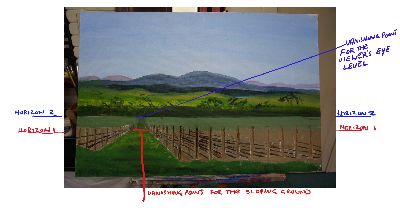American Folk Art: Grandma Moses
Most art styles are easy to define because they have distinctive features and techniques or were produced in a particular period of time. For example, Cubism was an early C20th painting style which abandoned one point perspective and used geometric shapes and interlocking planes to produce an image. But Folk Art can’t be so easily defined as it can be seen to include Naive Art, Art Brut (Raw or Rough Art) and Outsider Art. Often with each of these styles the artists are considered to have had no formal training in art skills which can be misleading as many folk artists were (or are) highly trained in their craft. And I should point out that there are some mainstream artists who have had no formal training.
I like to define Folk Art (and its many variations) as art produced by a person who paints according to their own perception of the world with none of the conventional art rules as important as the image. These artists usually work directly from their cultural and societal background and these influences also over-ride the rules of painting. Typically folk art is not influenced by movements in professional, academic or fine art circles. Folk Art could be seen as painting by ordinary people for ordinary people where the image is paramount and literal with little interest in implied meanings.
Within this context I refer you back to earlier posts on the Cornish Artists including:
Mary Jewels
Fred Yates
and the Swiss/Italian
Antonio Ligabue.
For the next couple of blogs I will promote Grandma Moses, certainly the first of the American Folk Artists I was aware of. Anna Mary Robertson Moses (1860–1961) began painting seriously at 78 years proving you are never too old to start. She gained her fame known as Grandma Moses and died at 101 years old, proving how good painting is for your health!
Anna Moses (nee Robertson) did paint as a child encouraged very much by her father Russell King Robertson who was also artistic. One of his landscapes has survived the passage of time.
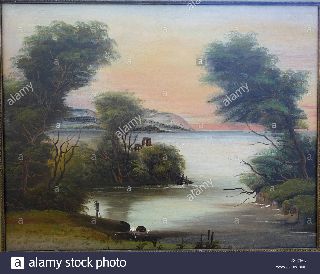
(Ref:Landscape by Russell King Robertson (1820 1909), c 1850 1880, oil on canvas Bennington Museum Bennington, Contributor: Paul Fearn / Alamy Stock Photo)
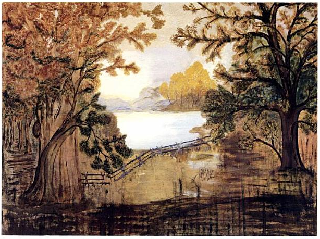
To quote from Anna: One time I was papering the parlor, and I ran short of paper for the fireboard. So I took a piece of paper and pasted it over the board, and I painted it a solid color first, then I painted two large trees on each side of it, like butternut trees. And back in it I did a little scene of a lake and painted it a yellow color, really bright, as though you were looking off into the sun light. In the front, to fill in that space, I brought in big bushes. I daubed it all on with the brush I painted the floor with. It run on three of four years, and we re-papered the palor and papered over the picture. When we re-papered the room again a few years ago, we took the paper off the fireboard, but the colours had faded somewhat. That was my first large picture. (Ref: Kallir, Otto Grandma Moses, Harrison House/Harry N.Abrams, Inc. New York, 1973)
As you might note, Anna exhibited considerable knowledge of painting techniques from the beginning which were learnt most likely from her father. She was not the usual self-taught naive artist which some people associate with her works.
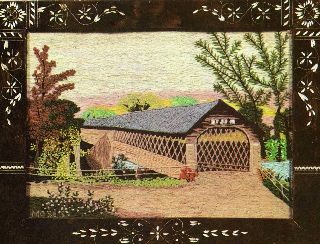
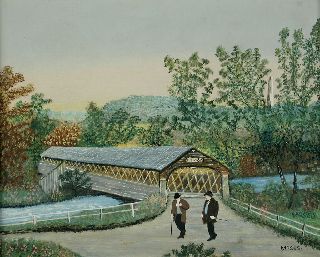
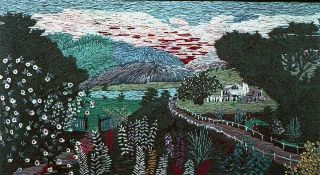
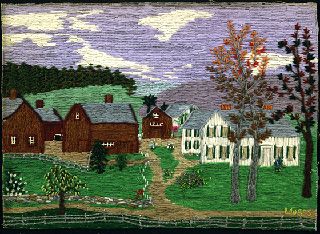
It was Anna's sister Celestia who encouraged her to try her hand at painting some of her yarn pictures. For her first picture Grandma used a piece of canvas, and some old house paint. (Ref: Kallir, Otto Grandma Moses, Harrison House/Harry N.Abrams, Inc. New York, 1973)
Louis Caldor, an art collector from New York saw some of Anna's paintings in 1938 and decided to promote her work. At first no one was interested in the paintings of an unknown elderly woman. Caldor managed to get three of Anna's paintings accepted for the Contemporary Unknown American Painters Exhibition being held in the Members' Rooms of the Museum of Modern Art in New York in 1939. I can't find good images of these paintings to show you and sadly none sold. However Caldor didn't give up and began providing Anna with better painting materials.
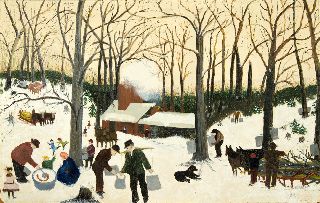
What appealed to Kallir about the painting was the way in which the artist had handled the landscape. While the figures were done in a rather clumsy fashion, the landscape was painted with astonishing mastery. Though she had never heard of any rules of perspective, Mrs. Moses had achieved an impression of depth, passing from the tall bare trees in the foreground, the huts and large, clearly outlined groups, to hazy tones in the distance, where smoke rising from the chimney mingled with the bluish gray of an early morning in winter, creating an atmosphere of compelling truth and closeness to nature.' (Kallir, Otto Grandma Moses, Harrison House/Harry N.Abrams, Inc. New York, 1973)
What appealed to Kallir about the painting was the way in which the artist had handled the landscape. While the figures were done in a rather clumsy fashion, the landscape was painted with astonishing mastery. Though she had never heard of any rules of perspective, Mrs. Moses had achieved an impression of depth, passing from the tall bare trees in the foreground, the huts and large, clearly outlined groups, to hazy tones in the distance, where smoke rising from the chimney mingled with the bluish gray of an early morning in winter, creating an atmosphere of compelling truth and closeness to nature.'
(Kallir, Otto Grandma Moses, Harrison House/Harry N.Abrams, Inc. New York, 1973)
In the next post we will look at some more of the paintings created by Grandma Moses.
Credit:
- Images from: Kallir, Otto Grandma Moses, Harrison House/Harry N.Abrams, Inc. New York, 1973
From the Studio I have a new student who is willing to show you his progress and learning so from time to time you will see his works as they develop. K from Wheelers Hill is painting a landscape of a vineyard using this photo for his starting image.
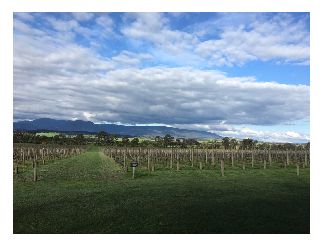
He has completed Stage One of the painting where the basic shapes of the image have been blocked out in the basic colours using acrylic paint. Notice how the middle ground is brighter which helps lead the viewer's eye from the feature of the vines in the foreground to the distant mountains.
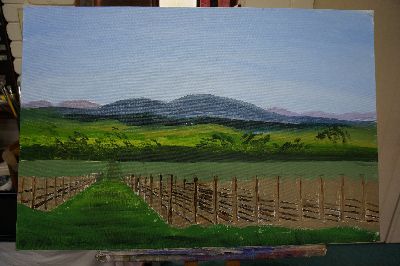
You will also notice that the vines are sloping downhill which means the painting has two horizons and two vanishing points.
